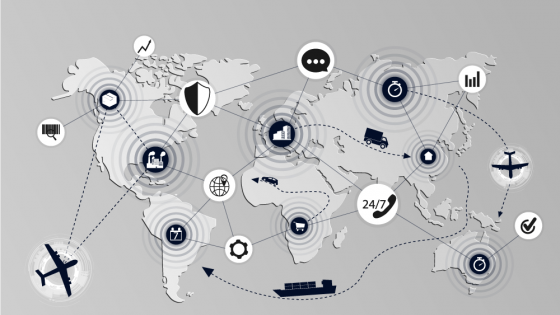Global supply chains are a central feature of the world economy. As most countries enter Covid-19 related lockdowns, there are concerns about both the present and the future of global supply chains. In the present, global supply chains are widely believed to transmit the crisis across countries (Baldwin and Freeman 2020). The future is forecasted to bring about at least some renationalisation of the supply chains (Javorcik 2020). This retrenchment of supply chains could be given an impetus by protectionist and nationalist policies that may come in the wake of the pandemic (Baldwin and Evenett 2020).
Our recent paper (Bonadio et al. 2020) performs a quantitative assessment of the role of global supply chains in the pandemic. We address two questions.
- First, how much did foreign lockdowns contribute to coronavirus-related GDP contractions?
- Second, would renationalising global supply chains insulate countries from future epidemic-related contractions in labour supply?
The quantification model
We use a quantitative model of world production and trade covering 64 countries on six continents and 33 sectors spanning all economic activities. We parameterise the model using the OECD Inter-Country Input-Output (ICIO) Tables that provide matrices of domestic and international intermediate input and final use trade. We start by simulating a global lockdown as a contraction in labour supply. To discipline the size of the labour contraction, we use the Dingel and Neiman (2020) measure of the fraction of the work of different occupations that can be done at home. Variation across sectors in their usage of different occupations and of countries in their sectoral employment composition then results in heterogeneous incidence of the shock across countries. Countries also vary in the stringency of lockdown measures. To capture this, we interact the work from home intensity by occupation with an index capturing the country-level stringency from the Oxford Blavatnik School of Government Coronavirus Government Response Tracker (Hale et al. 2020).
Results
The blue-white combination bars in Figure 1 display the GDP drops across all countries predicted by our baseline model following the labour supply shock. The four panels group countries into geographical regions. The GDP reductions are dramatic, at -31.5% on average. There is a significant amount of dispersion, with GDP reductions ranging from -21% in Taiwan and Sweden (which famously imposed one of the most lenient lockdown policies) to -40% in Vietnam.
Figure 1 GDP responses to the pandemic-related labour supply shock
Our focus is on the role of the global supply chains in particular. Using the tools from Huo et al. (2020), we compute the share of each country's GDP contraction that is due to foreign, rather than domestic, shocks. The white parts of the bars denote the contribution of foreign shocks. Foreign shocks transmitted through the global supply chains are responsible for a sizeable minority of the overall GDP contraction. The mean contribution of foreign shocks to the fall in GDP is about one third of the total. That is, an average country would experience an 11% GDP contraction purely due to the foreign lockdowns, even if it did not impose any lockdown on its own economy.
The economies with the largest foreign shock contributions (in proportional terms) are among those most tightly integrated into the global supply chains: Brunei, Kazakhstan, Saudi Arabia, Chile, and Colombia. Among these five countries, foreign shocks account for 57% of the total contraction on average.
Would supply chain repatriation have made a difference?
We next tackle the more substantive question of whether participation in global supply chains exacerbated or alleviated the pandemic-induced contraction in labour supply. It is not clear whether supply chain renationalisation will actually make GDP more resilient to future pandemic-type shocks. Figuring this out requires comparing the pandemic-induced GDP change in the baseline model to the pandemic-induced GDP change in an alternative world without international trade, where supply chains have adjusted to use only domestic inputs. Naturally, renationalisation of global supply chains would change the relative size of domestic sectors, as input users shift from foreign to domestic intermediates.
The answer is that by and large, severing global supply chains will not make countries more resilient to pandemic-style labour supply shocks. The grey bars in Figure 1 plot counterfactual declines in GDP for the same shock in a world where supply chains are domestic. It turns out that on average in our 64 countries, the downturn would actually be slightly worse with renationalised supply chains (-32.3% on average) than under current levels of trade. The intuition for this finding is simple: eliminating reliance on foreign inputs increases the reliance on domestic inputs. Since any national pandemic-related lockdown also affects domestic sectors, there is generally no resilience benefit from renationalising the international supply chains.
There is a modest distribution of differences around the average. In some countries, GDP would drop by four percentage points more if supply chains were renationalised, whereas in others GDP would fall by about four to six percentage points less. The cross-country variation is well-explained by differences in lockdown severity across countries. Some countries – most prominently Japan, Taiwan, Sweden, and Greece – imposed less stringent lockdowns in response to the pandemic shock. The domestic pandemic-induced shock is therefore smaller in these countries than the shock in their trading partners with more severe lockdowns. Separating from the global supply chains would make these countries more resilient to lockdowns by eliminating the transmission of the relatively larger shock from other countries. By contrast, a country with the most severe lockdown will reduce its own domestic labour supply by more than its average trading partner. In that case, the supply of the domestic intermediate inputs falls by more than the supply of foreign ones, and thus the GDP contraction is larger when supply chains are renationalised.
Another potential channel that may affect the benefits of supply chain renationalisation is a shift of the relative size of sectors within a country. All else equal, a country would be better off if renationalisation leads to expansion of sectors that are less exposed to negative labour supply shocks. A sector is less exposed to the pandemic-related lockdown if much of its labour input can be provided from home. Though plausible, we found that this channel is quantitatively less important compared to the aforementioned effect of shifting from foreign to domestic inputs.
Concluding remarks
All in all, our results show that global supply chains clearly transmit the economic effects of the lockdowns across borders. However, that does not mean that the presence of global supply chains uniformly exacerbates the downturn. Whether renationalising supply chains insulates a country from the pandemic depends on whether it plans to impose a more or less severe lockdown than its trading partners.
References
Baldwin, R and R Freeman (2020), “Supply chain contagion waves: Thinking ahead on manufacturing ‘contagion and reinfection’ from the COVID concussion”, VoxEU.org, 1 April.
Baldwin, R and S Evenett (2020), COVID-19 and Trade Policy: Why Turning Inward Won’t Work, a VoxEU.org eBook, CEPR Press.
Bonadio, B, Z Huo, A A Levchenko and N Pandalai-Nayar (2020), “Global Supply Chains in the Pandemic”, CEPR Discussion Paper 14766.
Javorcik, B (2020), “Global supply chains will not be the same in the post-COVID-19 world”, Chapter 8 in R Baldwin and S Evenett (eds.), COVID-19 and Trade Policy: Why Turning Inward Won’t Work, a VoxEU.org eBook, CEPR Press.
Dingel, J and B Neiman (2020), “How many jobs can be done at home?”, VoxEU.org, 7 April.
Hale, T, S Webster, A Petherick, T Phillips and B Kira (2020), “Oxford COVID-19 Government Response Tracker”, Blavatnik School of Government, Data use policy: Creative Commons, Attribution CC BY standard.
Huo, Z, A A Levchenko and N Pandalai-Nayar (2020), “International Comovement in the Global Production Network”, NBER Working Paper 25978.
Endnotes
1 Note that these are not annualised and are interpretable as the flow reductions in GDP while the lockdown is ongoing. These are not forecasts of the annual 2020 GDP contraction relative to 2019.








